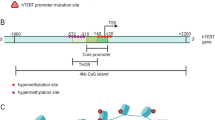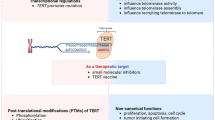Abstract
Background
Telomerase, a ribonucleoprotein enzyme mainly consisted of a catalytic protein subunit human telomerase reverse transcriptase (hTERT) and a human telomerase RNA component, is responsible for maintaining telomeres. Telomerase over-expression correlates significantly with tumors and is a prognostic marker. However, telomerase over-expression in breast cancers and the effect of telomerase inhibition as a candidate cancer therapy are unknown.
Methods
We used the dominant-negative mutant of hTERT (DN-hTERT) to inhibit telomerase activity on human breast adenocarcinoma cell line MCF-7 by transfection. Telomeric repeat amplification protocol assays and real-time quantitative RT-PCR were performed to investigate telomerase activity as well as expression of hTERT. Telomere length was measured by the flow-fluorescence in situ hybridization assay. Cell proliferation was assessed by the WST-8 assay, and apoptosis was evaluated by flow cytometry. The tumor formation ability of MCF-7 cells was investigated by transplanting cells subcutaneously into BALB/c nude mice.
Results
Ectopic expression of DN-hTERT caused dramatically inhibition of telomerase activity and reduction of telomere length. Telomerase inhibition induced growth arrest and apoptosis of MCF7 cells in vitro and loss of tumorigenic properties in vivo.
Conclusion
This study shows that telomerase inhibition by DN-hTERT can effectively inhibit the cell viability and tumorigenicity of MCF7 cells and is an attractive approach for breast cancer therapy.




Similar content being viewed by others
Abbreviations
- DN-hTERT:
-
Dominant negative-human telomerase reverse transcriptase
- hTR:
-
Human telomerase RNA
- hTERT:
-
Human telomerase reverse transcriptase
- PCR:
-
Polymerase chain reaction
- TRAP:
-
Telomeric repeat amplification protocol
References
DeSantis C, Siegel R, Bandi P, Jemal A. Breast cancer statistics, 2011. CA Cancer J Clin. 2011;61:409–18.
Jemal A, Bray F, Center MM, Ferlay J, Ward E, Forman D. Global cancer statistics. CA Cancer J Clin. 2011;61:69–90.
Coughlin SS, Ekwueme DU. Breast cancer as a global health concern. Cancer Epidemiol. 2009;33:315–8.
Moyzis RK, Buckingham JM, Cram LS, Dani M, Deaven LL, Jones MD, et al. A highly conserved repetitive DNA sequence, (TTAGGG)n, present at the telomeres of human chromosomes. Proc Natl Acad Sci USA. 1988;85:6622–6.
Zakian VA. Telomeres: beginning to understand the end. Science. 1995;270:1601–7.
Grandin N, Charbonneau M. Protection against chromosome degradation at the telomeres. Biochimie. 2008;90:41–59.
Cohen SB, Graham ME, Lovrecz GO, Bache N, Robinson PJ, Reddel RR. Protein composition of catalytically active human telomerase from immortal cells. Science. 2007;315:1850–3.
Shay JW, Wright WE. Senescence and immortalization: role of telomeres and telomerase. Carcinogenesis. 2005;26:867–74.
Hiyama E, Hiyama K, Yokoyama T, Shay JW. Immunohistochemical detection of telomerase (hTERT) protein in human cancer tissues and a subset of cells in normal tissues. Neoplasia. 2001;3:17–26.
Kim NW, Piatyszek MA, Prowse KR, Harley CB, West MD, Ho PL, et al. Specific association of human telomerase activity with immortal cells and cancer. Science. 1994;266:2011–5.
Carey LA, Kim NW, Goodman S, Marks J, Henderson G, Umbricht CB, et al. Telomerase activity and prognosis in primary breast cancers. J Clin Oncol. 1999;17:3075–81.
Hahn WC, Stewart SA, Brooks MW, York SG, Eaton E, Kurachi A, et al. Inhibition of telomerase limits the growth of human cancer cells. Nat Med. 1999;5:1164–70.
Naldini L, Blomer U, Gallay P, Ory D, Mulligan R, Gage FH, et al. In vivo gene delivery and stable transduction of nondividing cells by a lentiviral vector. Science. 1996;272:263–7.
Wyatt HD, Tsang AR, Lobb DA, Beattie TL. Human telomerase reverse transcriptase (hTERT) Q169 is essential for telomerase function in vitro and in vivo. PLoS One. 2009;4:e7176.
Wang F, Zhou H, Xia X, Sun Q, Wang Y, Cheng B. Activated Notch signaling is required for hepatitis B virus X protein to promote proliferation and survival of human hepatic cells. Cancer Lett. 2010;298:64–73.
Martens UM, Brass V, Sedlacek L, Pantic M, Exner C, Guo Y, et al. Telomere maintenance in human B lymphocytes. Br J Haematol. 2002;119:810–8.
Guide for the care and use of laboratory animals. Guide for the care and use of laboratory animals. 8th ed. Washington: National Academies Press; 2011.
Chan SR, Blackburn EH. Telomeres and telomerase. Philos Trans R Soc Lond B Biol Sci. 2004;359:109–21.
Rhyu MS. Telomeres, telomerase, and immortality. J Natl Cancer Inst. 1995;87:884–94.
Neidle S, Parkinson G. Telomere maintenance as a target for anticancer drug discovery. Nat Rev Drug Discov. 2002;1:383–93.
Shay JW, Bacchetti S. A survey of telomerase activity in human cancer. Eur J Cancer. 1997;33:787–91.
Shay JW, Zou Y, Hiyama E, Wright WE. Telomerase and cancer. Hum Mol Genet. 2001;10:677–85.
Meyerson M. Role of telomerase in normal and cancer cells. J Clin Oncol. 2000;18:2626–34.
Parkinson EK, Minty F. Anticancer therapy targeting telomeres and telomerase: current status. BioDrugs. 2007;21:375–85.
Sachsinger J, Gonzalez-Suarez E, Samper E, Heicappell R, Muller M, Blasco MA. Telomerase inhibition in RenCa, a murine tumor cell line with short telomeres, by overexpression of a dominant negative mTERT mutant, reveals fundamental differences in telomerase regulation between human and murine cells. Cancer Res. 2001;61:5580–6.
Chin K, de Solorzano CO, Knowles D, Jones A, Chou W, Rodriguez EG, et al. In situ analyses of genome instability in breast cancer. Nat Genet. 2004;36:984–8.
Hochreiter AE, Xiao H, Goldblatt EM, Gryaznov SM, Miller KD, Badve S, et al. Telomerase template antagonist GRN163L disrupts telomere maintenance, tumor growth, and metastasis of breast cancer. Clin Cancer Res. 2006;12:3184–92.
Joseph I, Tressler R, Bassett E, Harley C, Buseman CM, Pattamatta P, et al. The telomerase inhibitor imetelstat depletes cancer stem cells in breast and pancreatic cancer cell lines. Cancer Res. 2010;70:9494–504.
Price JE, Polyzos A, Zhang RD, Daniels LM. Tumorigenicity and metastasis of human breast carcinoma cell lines in nude mice. Cancer Res. 1990;50:717–21.
Acknowledgments
This work was financially supported by the National Science Foundation of China (No. 30500596).
Conflict of interest
The authors declare that they have no competing interests.
Author information
Authors and Affiliations
Corresponding author
Additional information
Yaojian Rao and Wei Xiong are jointly first authors contributed equally to this work.
About this article
Cite this article
Rao, Y., Xiong, W., Liu, H. et al. Inhibition of telomerase activity by dominant-negative hTERT retards the growth of breast cancer cells. Breast Cancer 23, 216–223 (2016). https://doi.org/10.1007/s12282-014-0553-z
Received:
Accepted:
Published:
Issue Date:
DOI: https://doi.org/10.1007/s12282-014-0553-z




